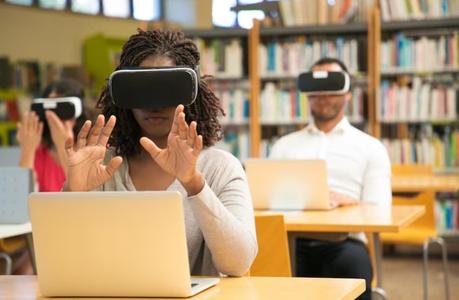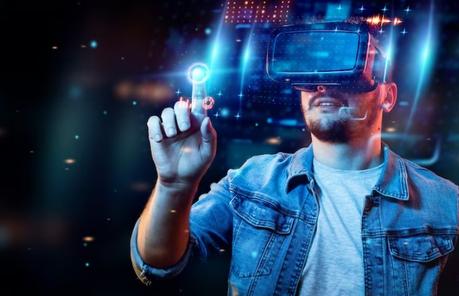
In today's rapidly evolving educational landscape, a powerful paradigm shift is occurring with the emergence of immersive learning environments. These innovative educational platforms transcend traditional classroom settings, offering students an engaging and dynamic approach to acquiring knowledge and skills. With the ever-accelerating pace of technological advancement, educators and learners alike find themselves on the cusp of a profound transformation in the way education is delivered and experienced.
In this comprehensive exploration, we delve into the realm of immersive learning, uncovering its core components, advantages, defining characteristics, objectives, and its potential to not only enhance but fundamentally reshape the future of education.
What is Immersive Learning Environment?
An immersive learning environment is an educational setting that utilizes advanced technologies like Virtual Reality (VR), Augmented Reality (AR), or Mixed Reality (MR) to create engaging and interactive learning experiences. In these environments, students are fully immersed in virtual or augmented worlds, promoting active learning through real-world simulations and enhancing understanding, retention, and critical thinking.
Essential Elements of Immersive Learning Environments
Immersive learning environments represent a fusion of technology and education, offering a transformative approach to how knowledge and skills are acquired. These environments encompass several key components that serve as the building blocks for engaging and dynamic educational experiences. Let's explore the essential elements that define immersive learning:
Virtual Reality (VR)
Virtual Reality (VR) technology immerses users in computer-generated environments. In education, VR facilitates immersive experiences by transporting students to historical events, remote locations, or even inside the human body for an extraordinary biology lesson. The allure of VR lies in its ability to enhance engagement and foster improved information retention. However, challenges include cost considerations and accessibility constraints.
Augmented Reality (AR)
Augmented Reality (AR) overlays digital information onto the real world. In educational contexts, AR applications and devices can transform traditional textbooks into interactive experiences or bring artwork to life within museum exhibits. AR's unique advantage lies in its capacity to seamlessly merge the physical and digital realms, although it may require specific hardware and software infrastructure.
Mixed Reality (MR)
Mixed Reality (MR) merges elements of both VR and AR, creating a seamless blend of the virtual and physical worlds. MR allows students to interact with virtual objects in their real-world surroundings. Its adaptability has found applications in diverse fields, including medical training and architectural design. Nevertheless, MR necessitates sophisticated hardware and expertise in development.
Benefits of Immersive Learning Environments
These advantages redefine how students engage with and absorb knowledge, creating a dynamic and inclusive educational landscape. Here are the key benefits of immersive learning:
- Enhanced Engagement: Immersive learning captivates students' attention in ways that traditional methods cannot. Its multisensory nature draws learners into the subject matter, making the educational experience more enjoyable and compelling.
- Improved Retention and Understanding: Interactivity and realism within immersive learning environments contribute to enhanced understanding and improved information retention. Complex concepts that were once abstract become tangible and memorable.
- Real-world Application: Immersive learning encourages students to apply their acquired knowledge to real-world scenarios. For example, engineering students can simulate the construction of bridges, equipping them with practical skills for future projects.
- Inclusivity and Accessibility: Immersive learning can be adapted to accommodate diverse learning styles and abilities, promoting inclusivity and accessibility in education.
- Personalized Learning: Customized experiences are made possible with immersive learning, allowing students to progress at their own pace and explore their individual interests and strengths.
Technologies and Tools for Immersive Learning
In the rapidly advancing landscape of immersive education, an array of technologies and tools play a pivotal role in shaping the learning experience. These tools and technologies empower educators to bridge the gap between traditional instruction and immersive learning. Let's delve into the key components of this technological ecosystem:
VR Headsets and Hardware
A wide array of VR headsets and hardware options are available, catering to diverse budgets and technical requirements. Choices range from high-end devices like the Oculus Rift to more affordable alternatives, enabling educators to select the most suitable equipment.

AR Apps and Devices
AR experiences can be accessed through common smartphones or specialized AR glasses and wearables. While smartphone-based AR is widely accessible, AR glasses offer a more immersive and hands-free experience.
Software and Platforms
Essential software and platforms enable educators to create, manage, and deliver immersive learning content effectively. Learning management systems, content creation tools, and simulation software empower instructors to design and administer immersive lessons tailored to their students' needs.
Conclusion
Immersive learning environments represent a profound shift in education, offering engaging, informative, and empowering experiences. While challenges such as cost and accessibility persist, the transformative potential within traditional education systems is undeniable. As educators and technology innovators continue to push the boundaries of immersive learning, the future of education promises to be a more captivating and effective endeavor. This shift holds the promise of revolutionizing how knowledge and skills are acquired in the digital age.

